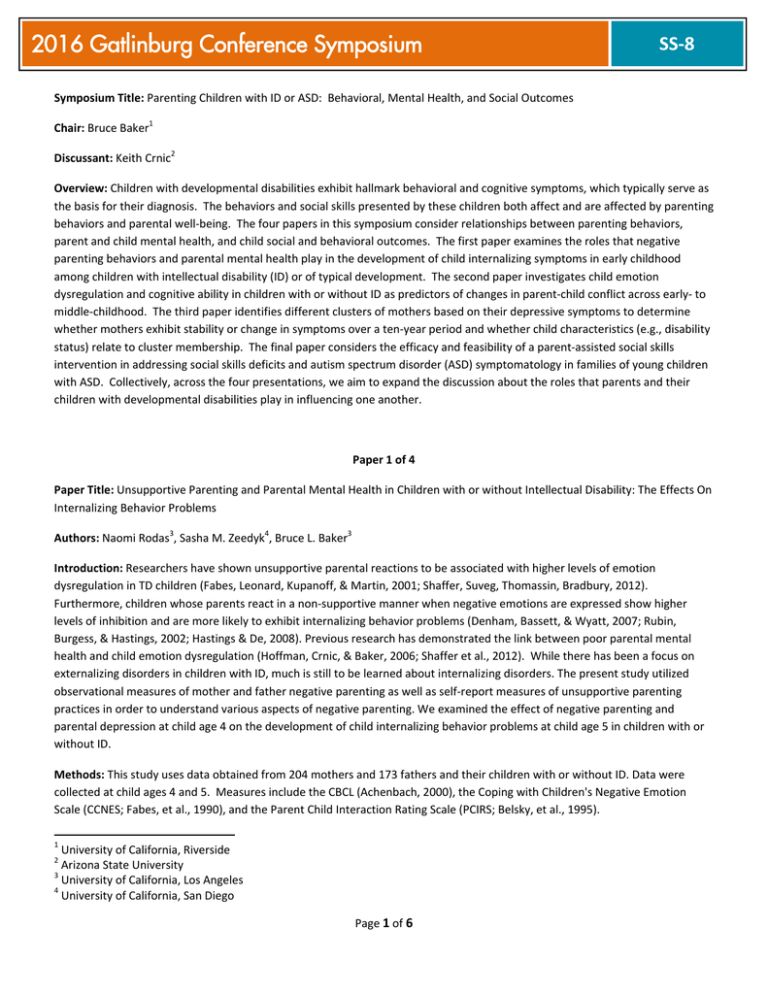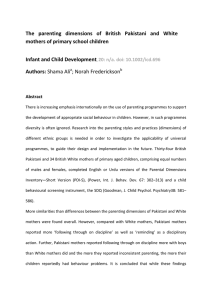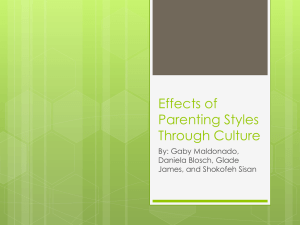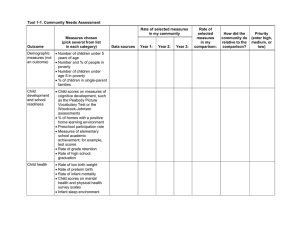2016 Gatlinburg Conference Symposium SS‐8
advertisement

2016 Gatlinburg Conference Symposium SS‐8 Symposium Title: Parenting Children with ID or ASD: Behavioral, Mental Health, and Social Outcomes Chair: Bruce Baker1 Discussant: Keith Crnic2 Overview: Children with developmental disabilities exhibit hallmark behavioral and cognitive symptoms, which typically serve as the basis for their diagnosis. The behaviors and social skills presented by these children both affect and are affected by parenting behaviors and parental well‐being. The four papers in this symposium consider relationships between parenting behaviors, parent and child mental health, and child social and behavioral outcomes. The first paper examines the roles that negative parenting behaviors and parental mental health play in the development of child internalizing symptoms in early childhood among children with intellectual disability (ID) or of typical development. The second paper investigates child emotion dysregulation and cognitive ability in children with or without ID as predictors of changes in parent‐child conflict across early‐ to middle‐childhood. The third paper identifies different clusters of mothers based on their depressive symptoms to determine whether mothers exhibit stability or change in symptoms over a ten‐year period and whether child characteristics (e.g., disability status) relate to cluster membership. The final paper considers the efficacy and feasibility of a parent‐assisted social skills intervention in addressing social skills deficits and autism spectrum disorder (ASD) symptomatology in families of young children with ASD. Collectively, across the four presentations, we aim to expand the discussion about the roles that parents and their children with developmental disabilities play in influencing one another. Paper 1 of 4 Paper Title: Unsupportive Parenting and Parental Mental Health in Children with or without Intellectual Disability: The Effects On Internalizing Behavior Problems Authors: Naomi Rodas3, Sasha M. Zeedyk4, Bruce L. Baker3 Introduction: Researchers have shown unsupportive parental reactions to be associated with higher levels of emotion dysregulation in TD children (Fabes, Leonard, Kupanoff, & Martin, 2001; Shaffer, Suveg, Thomassin, Bradbury, 2012). Furthermore, children whose parents react in a non‐supportive manner when negative emotions are expressed show higher levels of inhibition and are more likely to exhibit internalizing behavior problems (Denham, Bassett, & Wyatt, 2007; Rubin, Burgess, & Hastings, 2002; Hastings & De, 2008). Previous research has demonstrated the link between poor parental mental health and child emotion dysregulation (Hoffman, Crnic, & Baker, 2006; Shaffer et al., 2012). While there has been a focus on externalizing disorders in children with ID, much is still to be learned about internalizing disorders. The present study utilized observational measures of mother and father negative parenting as well as self‐report measures of unsupportive parenting practices in order to understand various aspects of negative parenting. We examined the effect of negative parenting and parental depression at child age 4 on the development of child internalizing behavior problems at child age 5 in children with or without ID. Methods: This study uses data obtained from 204 mothers and 173 fathers and their children with or without ID. Data were collected at child ages 4 and 5. Measures include the CBCL (Achenbach, 2000), the Coping with Children's Negative Emotion Scale (CCNES; Fabes, et al., 1990), and the Parent Child Interaction Rating Scale (PCIRS; Belsky, et al., 1995). 1 University of California, Riverside Arizona State University 3 University of California, Los Angeles 4 University of California, San Diego 2 Page 1 of 6 2016 Gatlinburg Conference Symposium SS‐8 Results: Maternal depression was positively associated with child internalizing behavior problems, as indicated by a significant unstandardized regression coefficient (B= .27, t= 3.94 p<.001). Maternal depression was also positively associated with unsupportive parenting (B=.01, t= 2.13, p<.05). For fathers, the results indicated that the cross‐product term between unsupportive parenting and paternal depression on child internalizing behaviors was significant (B= 6.80, t= 2.54, p<.01). Follow‐ up analyses of the moderation indicated that unsupportive parenting was significantly associated with child internalizing behavior problems at clinical (conditional effect= 6.47, t= 2.67, p<.01), but not at sub‐clinical levels (conditional effect= ‐.33, t= ‐ .28, p=.78), of paternal depression. Discussion: Overall, we found similar relationships between parental depression and child internalizing problems for both mothers and fathers. However, we did found differences in self‐reported and observed negative parenting practices when comparing mothers and fathers. Therefore, our findings suggest that we should continue to study both mothers and fathers, as their impact is not always the same. References/Citations: Belsky, J., Crnic, K., & Gable, S. (1995). The determinants of co‐parenting in families with toddler boys: Spousal differences and daily hassles. Child development, 66(3), 629‐642. Fabes, R. A., Eisenberg, N., & Bernzweig, J. (1990). The coping with children's negative emotions scale: Procedures and scoring. Available from authors. Arizona State University. Fabes, R.A. Leonard, S.A., Kupanoff, K., & Martin, C.L. (2001). Parental coping with children's negative emotions: Relations with children's emotional and social responding. Child Development, 72(3), 907‐920. Denham, S. A., Bassett, H. H., & Wyatt, T. (2007). The socialization of emotional competence. Handbook of socialization: Theory and research, 614‐637. Hastings, P. D., & De, I. (2008). Parasympathetic regulation and parental socialization of emotion: Biopsychosocial processes of adjustment in preschoolers. Social Development, 17(2), 211‐238. Hoffman, C., Crnic, K. A., & Baker, J. K. (2006). Maternal depression and parenting: Implications for children's emergent emotion regulation and behavioral functioning. Parenting: Science and Practice, 6(4), 271‐295. Shaffer, A., Suveg, C., Thomassin, K., & Bradbury, L. L. (2012). Emotion socialization in the context of family risks: links to child emotion regulation. Journal of Child and Family Studies, 21(6), 917‐924. Paper 2 of 4 Paper Title: The Interactive Effects of Child Emotion Dysregulation and Cognitive Ability on Parent‐Child Conflict across Early‐To Middle‐Childhood Authors: Willa A. Marquis3, Amanda N. Norona3, Bruce L. Baker3 Introduction: Though previous findings have established a link between parent‐child conflict and youth mental health and social adjustment, few studies (e.g., Eisenberg et al., 2008) have examined how parent‐child conflict relates to emotion regulation. No studies to our knowledge have explored this relationship early in development, where understanding predictors of change in conflict could be especially salient for intervention (Smetana, 2008). Clarifying this underlying mechanism is particularly important for children with developmental delays, who are at a heightened risk for developing psychopathology (Baker et al., 2002). In the present study, we examined the interrelation of parent‐child conflict, child emotion dysregulation, and child cognitive ability and explored how emotion dysregulation and cognitive ability predict change in parent‐child conflict across early‐ to middle‐childhood (ages 3 to 7). Page 2 of 6 2016 Gatlinburg Conference Symposium SS‐8 Methods: Participants (N = 211) were from a longitudinal study of the development of psychopathology in children with developmental delays (N = 73) and typically developing children (N = 138). Level of parent‐child conflict was derived from naturalistic home observations of family interactions, while emotion dysregulation was measured using the Child Behavior Checklist ‐ Emotion Dysregulation Index (adapted from Samson et al., 2014). Cognitive ability was measured using a continuous IQ score assessed at age 5 years. Pearson correlations were conducted to examine interrelations of primary constructs, and we used PROCESS to examine the conditional interactive effects of child emotion dysregulation and IQ on change in parent‐child conflict from child ages 3 to 5 and ages 5 to 7 years. Results: Higher emotion dysregulation was associated with lower cognitive ability across ages (r = ‐.24 to ‐.23) and with higher levels of parent‐child conflict at all ages (r = .16 to .19) except the first observation at child age 3. Conflict was higher among children with lower IQ at age 5 (r = ‐.21) and was also higher, unexpectedly, among children with higher IQ at age 3 (r = .14). Parent‐child conflict increased from ages 3 to 5 only for those children with both high emotion dysregulation and low IQ (t = 2.73, p < .01; B[SE] interaction = ‐.03[.01], p = .04). From ages 5 to 7, conflict increased for children who had high emotion dysregulation and either low (t = 2.34, p = .02) or moderate IQ (t = 2.01, p < .05; B[SE] interaction = ‐.02[.01], p = .04). Discussion: We considered the results of our correlations in the context of parents' expectations of their child's behavior across childhood, such that conflict may be more closely linked to dysregulation in later years when dysregulated behaviors (e.g., tantrums) are less peer‐normative. We conceptualized our finding that conflict increased for children with high dysregulation and low IQ as indicative of the additive risk of cognitive delay and poor regulation in predicting family functioning across the developmental span. Finally, we also explored our results within a resilience framework and discussed implications for early intervention. From a strengths perspective, fostering emotion regulation skills early in development may be protective for family functioning in the presence of developmental vulnerability. References/Citations: Baker, B. L., Blacher, J., Crnic, K. & Edelbrock, C. (2002). Behavior problems and parenting stress in families of three year old children with and without developmental delays. American Journal on Mental Retardation, 107, 433‐444. Eisenberg, N. et al. (2008). Introduction and Conceptual Framework, in Understanding Mother‐Adolescent Conflict Discussions: Concurrent and Across‐Time Prediction from Youths' Dispositions and Parenting, Wiley‐Blackwell, Oxford, UK. Smetana, J. G. (2008). Conflicting views of conflict. Monographs of the Society for Research in Child Development, 73(2), 161‐168. Paper 3 of 4 Paper Title: Maternal Depressive Symptoms among Mothers of Children with or without ID: Investigating Longitudinal Stability and Transition Authors: Sasha M. Zeedyk4, George A. Marcoulides5, Jan Blacher1 Introduction: Few studies exist in the ID literature tracing maternal depression longitudinally. Of those published, most are limited to periods in either early childhood or adolescence. Moreover, the extant literature that examines maternal depression longitudinally has shown discrepancies, with some samples demonstrating changing symptoms over time (e.g., Glidden & Schoolcraft, 2003) and others showing stability (e.g., Carter et al., 2009). To our knowledge, latent transition analysis has not been applied to investigate depressive symptoms in samples that include mothers of children with or without ID. The present 5 University of California, Santa Barbara Page 3 of 6 2016 Gatlinburg Conference Symposium SS‐8 study aimed to identify different groups of mothers based on their depressive symptoms, to investigate whether mothers exhibited stability or change in symptoms over time, and to determine if predictors of changes in group membership could be identified. Methods: Preliminary analysis fitting a growth model to the maternal depressive symptom data indicated that, on average, mothers exhibited fairly stable levels of depressive symptoms (i.e., the slope estimate was not significant). However, the variance term for the slope of depressive symptoms indicated that there was significant variability between mothers. Further, a plot of predicted ordinary least squares depression trajectories showed a pattern indicating 3‐4 distinct groups of mothers (i.e., variability was also present in visual analysis of the plot). Results: Preliminary analysis fitting a growth model to the maternal depressive symptom data indicated that, on average, mothers exhibited fairly stable levels of depressive symptoms (i.e., the slope estimate was not significant). However, the variance term for the slope of depressive symptoms indicated that there was significant variability between mothers. Further, a plot of predicted ordinary least squares depression trajectories showed a pattern indicating 3‐4 distinct groups of mothers (i.e., variability was also present in visual analysis of the plot). A latent class analysis was then utilized to group mothers at each time point. Model fit using the Bayesian Information Criterion index indicated that a 4‐class model was the best fit to the data. The results indicated that mothers fell into either low, borderline, high or very high symptom groups. The number of mothers falling into each group remained fairly stable over time. While the majority of mothers fell into the low or borderline groups (i.e., not meeting the clinical cutoff of 16 on the CES‐D), 11‐ 17% (depending on the time point measured) fell into the high or very high groups, displaying symptoms well above the clinical cutoff. Additional analyses will be conducted to investigate whether mothers remained in the same group or transitioned between groups over time. Predictors of group membership and transition will be also investigated (e.g., child disability status, child behavior problems). Discussion: Using a measure of depressive symptoms with a non‐clinical sample of mothers of children with or without ID, four groups of mothers were identified, and these groups were present across the 9 time points measured. Analyzing the stability/transition of mothers within/between groups, and possible predictors for group membership, has the potential to extend the current literature base by determining whether different types of mothers are differentially affected by their children with or without ID. References/Citations: Carter, A.S., Martinez‐Pedraza, F.L., & Gray, S.A.O. (2009). Stability and individual change in depressive symptoms among mothers raising young children with ASD: Maternal and child correlates. Journal of Clinical Psychology, 65(12), 1270‐1280. Glidden, L.M., & Schoolcraft, S.A. (2003). Depression: Its trajectory and correlates in mothers rearing children with intellectual disability. Journal of Intellectual Disability Research: Special Issue on Family Research, 47, 250‐263. Marcoulides, G.A.M., Gottfried, A.E., Gottfried, A.W., & Oliver, P.H. (2008). A latent transition analysis of academic intrinsic motivation from childhood through adolescence. Educational Research and Evaluation, 14(5), 411‐427. Page 4 of 6 2016 Gatlinburg Conference Symposium SS‐8 Paper 4 of 4 Paper Title: Parent Assisted Social Skills Treatment in Early Childhood: The UCLA PEERS® For Preschoolers Program Authors: Elizabeth Laugeson6, Mi Na Park6, Yasamine Bolourian1, Jennifer Sanderson7 Introduction: Social impairments characteristic of Autism Spectrum Disorder (ASD) are evident in early childhood and are likely to worsen with development (Rao, Beidel, Murray, 2008). Despite the growing popularity of parent training and early intervention programs, few evidence‐based interventions exist that explicitly address the development of social skills in early childhood and actively integrate parents into treatment (DeRosier, Swick, Davis, McMillen, & Matthews, 2011). Objective: The purpose of this study was to assess the feasibility and efficacy of a parent‐assisted social skills intervention for preschool children with ASD using a randomized controlled design. Methods: Children between four to six years of age diagnosed with ASD without intellectual disabilities participated in this study with their parents. Treatment involved the adaptation of an existing empirically supported social skills intervention for young children with ASD (Sanderson & Laugeson, 2008) by integrating treatment elements of the UCLA Program for the Education and Enrichment of Relational Skills (PEERS®; Laugeson & Frankel, 2010), an evidence‐based social skills treatment for youth with ASD. Families attended weekly 90‐minute sessions delivered for 16 weeks in a small group format. Child sessions consisted of puppet‐ facilitated didactic lessons targeting key social skills, role‐playing demonstrations, and play‐based behavioral rehearsal of skills related to making and keeping friends. Parent sessions consisted of parent education and training, including review of socialization homework assignments, didactic lessons, and in‐vivo performance feedback from the treatment team while social coaching their children during play‐based activities. Blinded behavioral observation of autism symptoms and social functioning were assessed at pre‐ and post‐intervention using the Autism Diagnostic Observation Schedule ‐ Second Edition (ADOS‐2; Lord et al., 2012). Other treatment outcome measures completed by parents and independent blinded teachers at pre‐ and post‐treatment included the Social Responsiveness Scale, Second Edition (SRS‐2; Constantino, 2012), the Social Skills Improvement System (SSIS; Gresham & Elliot, 2008), and the Quality of Play Questionnaire (QPQ; Frankel & Mintz, 2010). Results: Difference scores (DS) were calculated to examine changes in social functioning following treatment. Preliminary findings from paired sample t‐tests of the open trial reveal a significant decrease in autism symptoms on the ADOS‐2 from a moderate range of autism symptoms to a low range following treatment (p<.05), as measured by blinded clinical raters. Additionally, significant improvements in overall social responsiveness on SRS T‐scores were observed in the areas of increased social communication (DS=5.1; p<.05), social awareness (DS=6.2; p<.05), social motivation (DS=6.5; p<.05), and decreased repetitive behaviors / restricted interests (DS=7.3; p<.05). Improvements in overall standardized scores of social skills (DS=4.9; p<.05) and decreased problem behaviors (DS=4.7; p<.05) on the SSIS were also observed, along with increased frequency of play dates on the QPQ (p<.05). No other statistically significant changes were observed across the outcome measures. Discussion: Findings from the current study address a gap in the research literature by demonstrating the benefit of a parent‐ assisted social skills intervention in early childhood for youth with ASD. 6 7 UCLA Semel Institute for Neuroscience and Human Behavior Florida Atlantic University Page 5 of 6 2016 Gatlinburg Conference Symposium SS‐8 References/Citations: DeRosier, M. E., Swick, D. C., Davis, N. O., McMillen, J. S., & Matthews, R. (2011). The efficacy of a social skills group intervention for improving social behaviors in children with high functioning autism spectrum disorders. Journal of autism and developmental disorders, 41(8), 1033‐1043. Laugeson, E. A. & Frankel, F. (2010). Social Skills for Teenagers with Developmental and Autism Spectrum Disorders: The PEERS Treatment Manual. New York, NY: Routledge. Rao, P. A., Beidel, D. C., & Murray, M. J. (2008). Social skills interventions for children with Asperger's syndrome or high‐ functioning autism: A review and recommendations. Journal of autism and developmental Page 6 of 6



